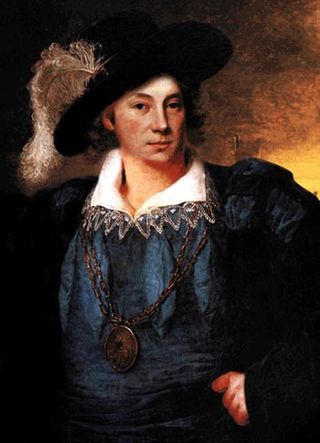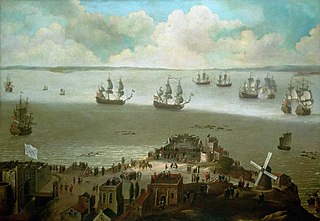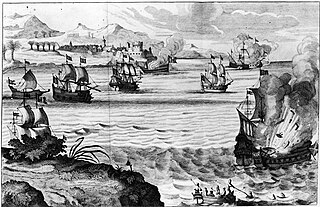Related Research Articles

The Cayman Islands are a British overseas territory located in the Caribbean that have been under various governments since their discovery by Europeans. Christopher Columbus sighted the Cayman Islands on May 10, 1503, and named them Las Tortugas after the numerous sea turtles seen swimming in the surrounding waters. Columbus had found the two smaller sister islands and it was these two islands that he named "Las Tortugas".

Sir Henry Morgan was a Welsh privateer, plantation owner, and, later, Lieutenant Governor of Jamaica. From his base in Port Royal, Jamaica, he and those under his command raided settlements and shipping ports on the Spanish Main, becoming wealthy as they did so. With the prize money and loot from the raids, Morgan purchased three large sugar plantations on Jamaica.

The Anglo-Spanish War was a conflict between the English Protectorate and Spain between 1654 and 1660. It was driven by the economic and religious rivalry between the two countries, with each side attacking the other's commercial and colonial interests in various ways, such as privateering and naval expeditions.
This timeline of the history of piracy in the 1680s is a chronological list of key events involving pirates between 1680 and 1689.

Charles Vane was an English pirate who operated in the Bahamas during the end of the Golden Age of Piracy.
Moses Cohen Henriques was a Dutch pirate of Portuguese Sephardic Jewish origin. Operating in the Caribbean, the total haul of his raids on the Spanish is estimated to be about 1 billion USD in today's value.
Henry Jennings was an English privateer-turned-pirate. Jennings's first recorded act of piracy took place in early 1716 when, with three vessels and 150–300 men, Jennings's fleet ambushed the Spanish salvage camp from the 1715 Treasure Fleet. After the Florida raid, Jennings and his crew also linked up with Benjamin Hornigold's "three sets of pirates" from New Providence Island.

Laurens Cornelis Boudewijn de Graaf was a Dutch pirate, mercenary, and naval officer in the service of the French colony of Saint-Domingue during the late 17th and early 18th century.
John Morris was an English buccaneer active in the Caribbean during the 1660s and early-1670s. His son, John Morris the Younger, held a command of his own ship during his father's later expeditions against Portobelo and Maracaibo. John Morris the Younger was one of the commanders killed in an explosion during a party on board Henry Morgan's flagship in 1670.

HMS Tyger, often spelled Tiger, was a 38-gun fourth rate frigate of the Royal Navy, built by Peter Pett II at Woolwich and launched in 1647. The term 'frigate' during the period of this ship referred to a method of construction, rather than a role which did not develop until the following century. Tyger was the third ship of the Royal Navy to bear the name, and by successive rebuildings she served for almost a century until she was wrecked in the Dry Tortugas in 1742. The ship's crew was stranded on Garden Key for 56 days, fighting off Spanish attempts to capture them, and then spent another 56 days sailing in small boats 700 miles (1,100 km) to Port Royal, Jamaica. Remarkably, only five crew members died during this period: three killed by the Spanish, and two others of natural causes. Six crewmen were captured and imprisoned by the Spanish. The captain and three of his lieutenants were court-martialed over the wreck and subsequent events.

Edward Mansvelt or Mansfield was a 17th-century Dutch corsair and buccaneer who, at one time, was acknowledged as an informal chieftain of the "Brethren of the Coast". He was the first to organise large scale raids against Spanish settlements, tactics which would be utilised to attack Spanish strongholds by later buccaneers in future years, and held considerable influence in Tortuga and Port Royal. He was widely considered one of the finest buccaneers of his day and, following his death, his position was assumed by his protégé and vice-admiral, Henry Morgan.

Pieter Adriaanszoon Ita was a 17th-century Dutch privateer. He was also an admiral in the Dutch West India Company and, in 1628, commanded a large expedition against Portuguese and Spanish interests in the Caribbean. The expedition was one of the largest of its time and included many of the great privateers of the era.
Bernard Claesen Speirdyke, also called Barnard or Bart Speirdyke, was a 17th-century Dutch buccaneer. His Dutch name Bernard Claesen Spierdijk suggests he may have come from the village of Spierdijk, North Holland.

The Flying Gang was an 18th-century group of pirates who established themselves in Nassau, New Providence in the Bahamas after the destruction of Port Royal in Jamaica. The gang consisted of the most notorious and cunning pirates of the time, and they terrorized and pillaged the Caribbean until the Royal Navy and infighting brought them to justice. They achieved great fame and wealth by raiding salvagers attempting to recover gold from the sunken Spanish treasure fleet. They established their own codes and governed themselves independent from any of the colonial powers of the time. Nassau was deemed the Republic of Pirates as it attracted many former privateers looking for work to its shores. The Governor of Bermuda stated that there were over 1,000 pirates in Nassau at that time and that they outnumbered the mere hundred inhabitants in the town.
Jelles de Lecat was a Dutch pirate and buccaneer who sailed for and against both the English and Spanish. He served with Henry Morgan and was often called "Yellahs," "Yallahs," or “Captain Yellows.”
Francis Witherborn was an English buccaneer, privateer, and pirate active in the Caribbean. He is best known for his brief association with Henry Morgan.
George Spurre was an English pirate and buccaneer. He is best known for sacking Campeche and for joining a large buccaneer force which captured Veracruz.

Henry Morgan's Panama expedition also known as the Sack of Panama, was an expedition that took place between 16 December 1670 and 5 March 1671 during the later stage of the Anglo-Spanish War. English privateers and French pirates commanded by Buccaneer Henry Morgan launched an attack with an army of 1,400 men with the purpose of capturing the rich Spanish city of Panama off the Pacific coast.

Henry Morgan's raid on Lake Maracaibo, also known as the Sack of Maracaibo and the Battle of Lake Maracaibo, was a military event that took place between 16 March and 21 May 1669 during the latter stage of the Anglo-Spanish War. English privateers commanded by notable Buccaneer Henry Morgan launched an attack with the purpose of raiding Spanish towns along the coastline inside of Lake Maracaibo in the Spanish Province of Venezuela.

Henry Morgan's raid on Puerto del Príncipe was a military event which took place during the latter stage of the Anglo-Spanish War between March and April 1668 on the Spanish island of Cuba. Some 700 Buccaneers in twelve ships led by Captain Henry Morgan landed in the Gulf of Santa María and marched to capture the inland town of Puerto del Príncipe.
References
- ↑ Lawson, Wood. Shipwrecks of the Cayman Islands: A Diving Guide to Historical & Modern Shipwrecks. Essex, UK: AquaPress, 2004. (pg. 21-22) ISBN 0-9544060-3-6
